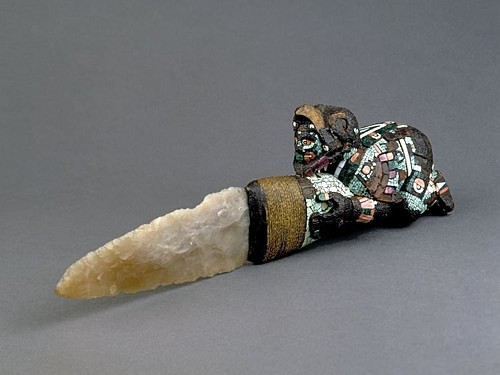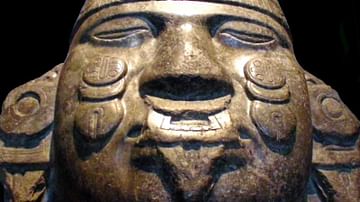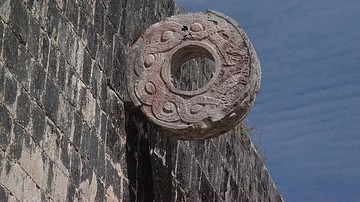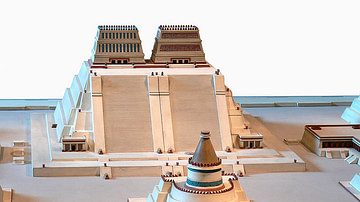The Aztec mosaic-handled knife currently in the British Museum, London dates to between 1400 and 1521 CE and is thought to have been used in religious ceremonies. Made from wood and flint the knife handle represents an Aztec warrior but the blade revealed no traces of blood under testing and so was probably not used to sacrifice victims, a common Aztec religious practice.
The ceremonial knife or ixcuac measures approximately 32 cm in length and 10 cm in height. The blade, made of flint, is inserted into the cedarwood (Cedrela odorata) handle and fixed in place with Protium resin and bound with a cord made from fibres of the maguey (Agave), a type of cactus. The flint of the blade has been repeatedly struck (knapped) to produce a very thin, semi-translucent blade which tapers to a sharp point.
The handle of the knife has been carved to resemble a crouching figure who wears the ritual costume of an Aztec eagle-warrior or cuauhtliocelotl, one of the most senior Aztec military ranks and also translated as eagle-jaguar. The figure is covered in mosaic made from small pieces of pale blue turquoise. Fine details such as eyes, teeth and fingernails are rendered using even smaller tesserae of dark green malachite and three different shell types: white conch (Strombus sp.), thorny oyster (Spondylus princeps) and mother-of-pearl (Pinctada mazatlantica). Other details picked out in malachite, conch and mother-of-pearl include jewellery such as bracelets, anklets, a chest decoration, and a nose ornament. The lips and gums of the smiling warrior are dramatically picked out using orange-red shell.
The mosaic tesserae are attached using pine and copal resin which is also used in places as a decorative inlay. Interestingly, the figure is himself clutching the knife with both hands. Typical of representations in Aztec art of eagle-warriors the figure wears a loincloth or maxtlatl, a winged cloak decorated with white stars and his head protrudes from a beaked headdress, also decorated with stars, representing the head of a bird of prey. The figure also wears something hanging down his back, perhaps made to represent a ray of the sun, a body closely associated with eagles and these particular warriors.
The knife is not unique as two similar types also survive with one now residing in the Museo Nazionale Preistorico ed Etnografico 'Luigi Pigorini' in Rome and the other in the National Museum of Anthropology in Mexico City. One of the roles of the elite eagle-warriors was to furnish sacrificial victims to 'feed' the sun with their hearts and blood so they make an entirely fitting subject for such ceremonial knives.





